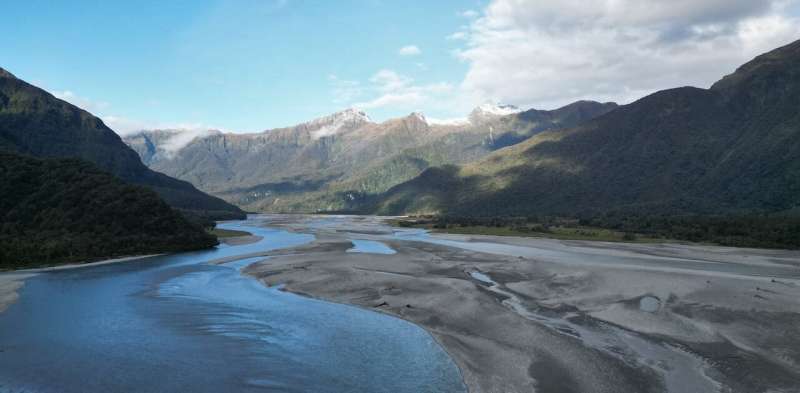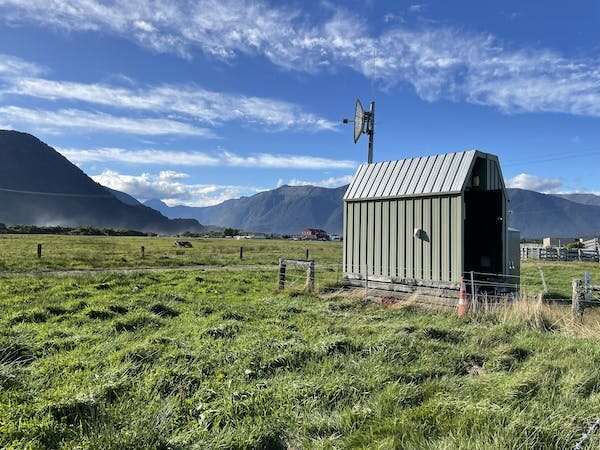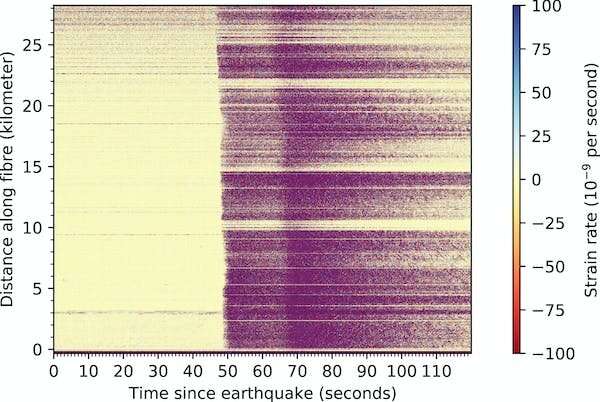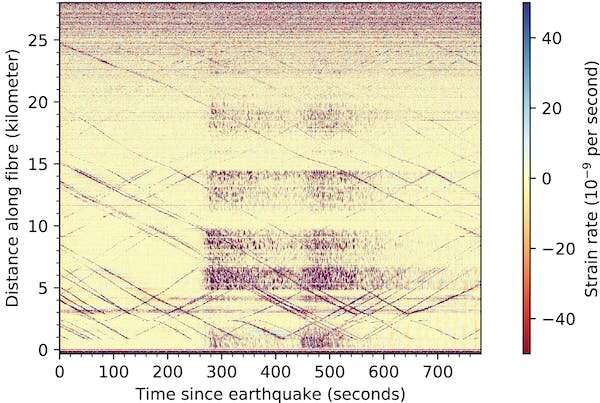This article has been reviewed according to Science X's editorial process and policies. Editors have highlighted the following attributes while ensuring the content's credibility:
fact-checked
trusted source
written by researcher(s)
proofread
Seismology at light speed: How fiber-optic telecommunications cables deliver a close-up view of Alpine Fault

Aotearoa New Zealand experiences frequent earthquakes, including destructive ones such as those that struck Christchurch in 2010 and 2011, and near Kaikōura in 2018.
In the South Island, the largest seismic hazard is the 600km Alpine Fault, which runs the length of the Southern Alps and defines the boundary between the Australian and Pacific tectonic plates.
Painstaking geological research has revealed it produces very large (magnitude 7-8) earthquakes about every 300 years—with the most recent one in 1717. Scientists estimate there's a 75% chance of a large Alpine Fault earthquake in the next 50 years. The odds of that earthquake being larger than magnitude 8 are 82%.
Despite the unparalleled quality of the paleo-seismic record of past Alpine Fault earthquakes, the next big earthquake will come without warning.
In anticipation of that event, geoscientists are working hard to understand how the Alpine Fault is being loaded prior to rupture and how characteristics of the fault may affect the rupture's propagation and the resulting ground shaking.
One component of this work is to determine the geometry and internal structure of the Alpine Fault at scales much finer than can be studied using conventional seismometers spaced tens of kilometers apart.

The Haast DAS experiment
A new experiment in Haast, a small, remote community near the coast in South Westland, is using technology called Distributed Acoustic Sensing (DAS). DAS is a rapidly emerging sensing technique that converts telecommunication fiber-optic cables into thousands of densely-spaced ground-motion sensors.
The Haast DAS experiment is a trans-Tasman collaboration between geophysicists from the Australian National University and Victoria University of Wellington Te Herenga Waka. It is the first of its kind across a major, active plate boundary fault, providing an unprecedented opportunity to study the internal structure of the Alpine Fault ahead of an anticipated large earthquake.
Between late February and early May this year, we made seismological measurements across the Alpine Fault using a computer-controlled laser system known as an interrogator attached to an unused ("dark") fiber within a telecommunications cable installed by Chorus to provide broadband connectivity across the South Island. The telecommunications cable crosses the Alpine Fault just east of Haast.
Fiber-optic seismology

Pulses of light emitted by the interrogator are scattered as they travel along the fiber and interact with atomic-scale imperfections in the glass. Some of this scattered light travels backward along the fiber to the interrogator.
Vibrations of the fiber caused by passing seismic waves modulate this scattering and can be detected by recording the scattered light pulses.
The interrogator we have been using makes a thousand measurements per second at each of 7250 locations, spaced four meters apart along the Haast Pass Highway. This produces a staggering volume of data: about 1Gb of new data every minute, or 1Tb of data every day.
The vibrations recorded at Haast include signals produced by nearby earthquakes (most of which are too small to be perceptible to humans) and other, larger earthquakes occurring throughout New Zealand and further afield. In mid-May, for example, we recorded several large earthquakes near New Caledonia, the largest of which prompted a Pacific tsunami warning.
The density of DAS measurements across the Alpine Fault provides an entirely new way of studying the fault's internal structure. Seismic waves arriving in Haast from different directions and vibrating the fiber have interacted with the Alpine Fault in ways that affect the waves themselves.
The DAS recording below shows two small earthquakes (magnitude 2 and 3), occurring south of Haast about 30 seconds apart.
Big data provides detailed information
By vastly increasing the effective number of sensors, DAS provides a new lens with which to study processes as diverse as the structure of glaciers, the expansion and contraction of volcanoes in response to magma movements, the interaction of ocean waves with the deep seafloor and the effects of groundwater extraction on land subsidence.
A new challenge for the geophysical community is learning how best to store, share, process and analyze large volumes of DAS data. High-performance computing and artificial intelligence techniques (AI) are being developed and adapted to these data to enable researchers to recognize and distinguish signals of different origins.
At Haast, for example, the records of earthquakes of most interest to seismologists are interspersed with noise produced by highway traffic. Being able to separate out these two types of information is a task well suited to AI. In the future, it is likely AI will help tease apart DAS data to detect otherwise unrecognized signals produced by atmospheric and subterranean processes.

DAS holds enormous promise for acquiring real-time, high-resolution measurements of processes using existing telecommunications infrastructure and rapid developments in AI and signal processing.
At Haast, it is providing fundamental new insights into the Alpine Fault ahead of the next big earthquake, informing the scientific analysis that underpins community preparedness and resilience.
Provided by The Conversation
This article is republished from The Conversation under a Creative Commons license. Read the original article.![]()




















